#(Naso brevirostris
Explore tagged Tumblr posts
Note
I love your blog, could you post animals related to fantasy?
I give you a unicorn, a dragon, and the dreaded basilisk...
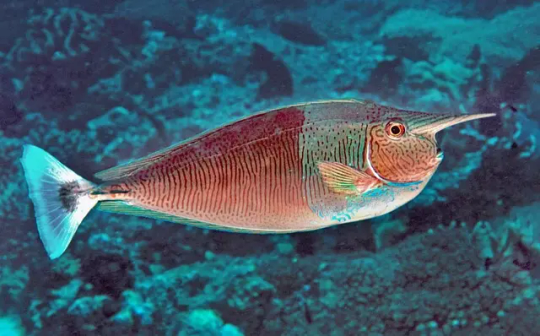
Spotted Unicornfish (Naso brevirostris), family Acanthuridae, order Acanthuriformes, found in the Indian Western Pacific Oceans
The unicorn horn on the unicornfish is called a "rostral protuberance", and no one really understands why they have them.
photograph by Paddy Ryan

Komodo Dragon (Varanus komodoensis), family Varanidae, found on Koomodo Island and other nearby islands in Indonesia
Venomous.
ENDANGERED.
It was once thought that Komodos subdue prey with a heavy and noxious array of mouth bacteria that infect bite wounds of prey after being bitten, but... it was never really determined scientifically if that's what was happening (conclusively, at least).
It turned out, they're venomous! Research was done in 2009 that found a primitive venom gland at the back of the mouth.
This is that largest species of lizard in the world, growing to a maximum total length of up to ~ 3 m (~10 ft.) long and a max. weight of up to 8~ 81 kg (180 lbs) (in the wild).
photograph by Andrew Yates
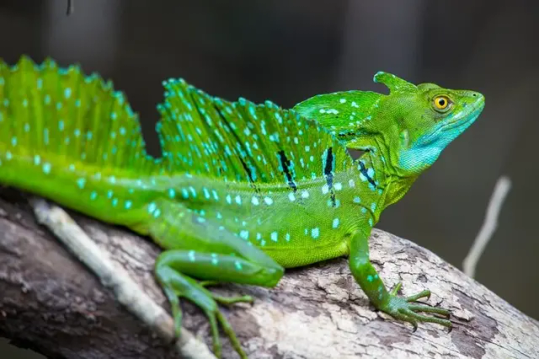
Green or Plumed Basilisk (Basiliscus plumifrons), male, family Corytophanidae, Nicuragua
Basilisks are capable of running across the water's surface to escape predators (sometimes called the Jesus Christ Lizard).
Photograph by eco2drew
#unicorn#unicornfish#fish#komodo dragon#dragon#lizard#monitor lizard#reptile#basilisk#herpetology#ichthyology#animals#nature
269 notes
·
View notes
Note
I'd love a fish
Fish for you!
Also that is a baller username

You get a Paletail Unicornfish
Naso brevirostris
24 notes
·
View notes
Text
Delfini rosa avvistati con cuccioli di specie completamente diverse in un incontro "misterioso". Delfini rosa avvistati con cuccioli di specie diverse Un raro cucciolo di delfino in via di estinzione è stato avvistato mentre nuotava con membri di una specie diversa in Cambogia, lasciando gli scienziati perplessi. Il delfino dell’Irrawaddy (Orcaella brevirostris), probabilmente con la madre in un gruppo di delfini megattere dell’Indo-Pacifico (Sousa chinensis). I delfini dell’Irrawaddy sono grigi scuri con il muso schiacciato, mentre i delfini megatteri dell’Indo-Pacifico sono rosa con il naso lungo. Avvistamento e reazioni degli esperti I ricercatori di Marine Conservation Cambogia (MCC) hanno dichiarato l’insolito avvistamento il 31 maggio. L’interazione è stata definita “estremamente insolita” poiché di
0 notes
Photo

Paletail unicornfish (Naso brevirostris) off the coast of the Seychelles
Rafi Amar
166 notes
·
View notes
Text
Unicorn Fish – Real or Hoax?
Unicorn Fish – Real or Hoax?
Many cryptozoology lovers were disappointed to learn that cute yellow elephant fish was a hoax, myself included. So when I saw this fascinating and gorgeous creature called a Unicorn fish, I thought, I’ll have to investigate that! Let me share my findings with you!
View On WordPress
0 notes
Text
The Great Barrier “Ralph”
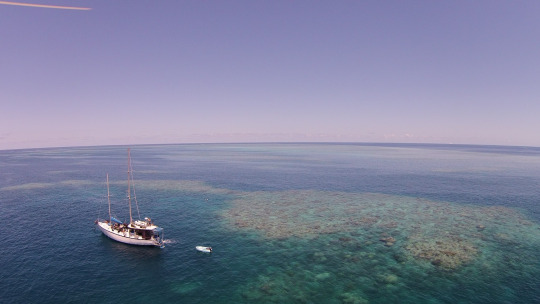
Tuesday and Wednesday I checked off one of my bucket list activities. I took an overnight boat and snorkelled thr the Great Barrier Reef. We visited one of the Outer Reefs, the Thetford Reef, 3 hours out from Cairns. One of the ost spectacular sites ever!
So full disclosure, this might be one of my least visual appealing posts because I did not have an underwater camera and really didn’t use my phone too much because everything on the boat is soaking wet all the time. Most of the pics from topside are mine, but all the fish/coral pics are courtesy of the internet. They are all things I really saw though..Anyway, sit back, put your comfy pants on, get a glass of wine...cause this is a long one.
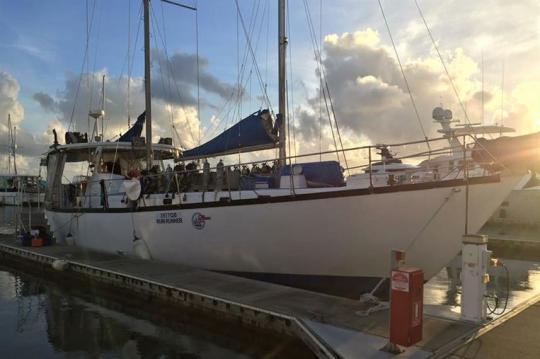
My Great Barrier Reef (GBR) voyage was aboard a small 65 foot motor sailing schooner called the Rum Runner. It was advertised as "an affordable reef experience for backpackers and budget-conscious travelers" (You know how I love a deal) It lives up to it's no frills expectations. The boat is owned by a man named Richard who is also known as Rum. He also owns the hostel I am staying at...another no frills frills experience. Rum is a kind of wiry frantic man, who when I told him that the door to the refrigerator fell off when I opened it, he said “Oh yeah, that...well, you can put your stuff in the other fridge.” Hmmm. No frills indeed. But it is actually a nice room with my own bed and A/C. All the basics covered.

Anyway, back to the reef...the captain of the Rum Runner was also quite a character. His name is Jace and he looks exactly like what you would imagine a grizzled sailor to look like (only he’s on the small side). Long, unkempt hair and covered in nautical tattoos,.His personality is a grizzled as his exterior would suggest. Classic! (No photo, use your imagination)

A motley crew
We were at full capacity on the small boat with 16 passengers and 5 crew. (I actually think we might have been over capacity, but its not the kind of boat that is concerned with that kind of thing.) My fellow passengers on the trip were a fun and eclectic mix of international backpackers hailing from 9 different countries including Japan, Germany, the Netherlands, the UK, New Zealand, France, etc.

The ride out to the reef was a 3 hour trip. It started with fun a chatting and general excitement. Things quickly turned sour. The reason I named this post The Great Barrier “Ralph” was due to the rough seas heading out to the reef and the puking/ralphing fest that ensued. Of the 16 passengers, at my best count 9 were lined up along the side of the ship throwing up for most of the ride out. A seasickness extravaganza. I was shockingly one of the only people not throwing up. Considering my general aversion to water for most of my early life, I was shocked to be one of the ones who had my sea legs. This air of cockiness would catch up to me later, but more to come on that...
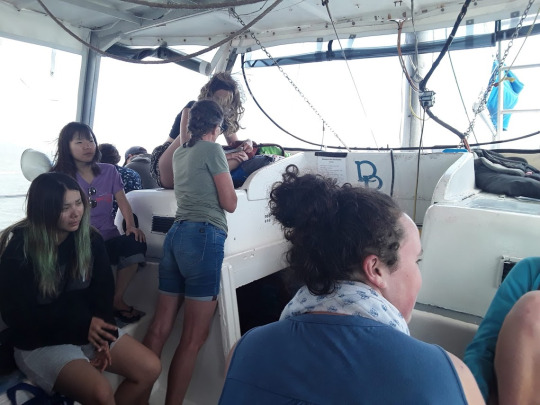
By the time we got out to the reef, most people, although a little sad, queasy and haggard had stopped ralphing over the side and it was time to get our diving/snorkeling on. Most of the passengers were certified divers. There were only three of us who opted for the snorkel only package, which proved to be the best decision. My snorkel buddies are my new favorite travel friends, Sophie & Oscar. Sophie is a “Kiwi” (a person from New Zealand) and Oscar, Sophie’s BF, is originally from Sweden. They would turn out to be my travel companions for the rest of my time in Cairns.
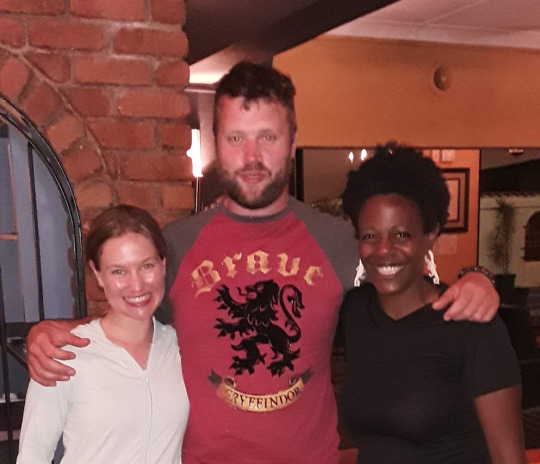
Snorkel buddies
The three of us had nearly free reign of the reef on each dive, as the crew was preoccupied with the divers. On day one, we did 4 dives at sites around an Outer Reef known as the Thetford Reef. Although the GBR is in danger due to global warming, it is absolutely huge and some parts of it are still flourishing. We were on just one of over 3,000 reef groups that make up the GBR!
So what is it like to snorkel in open ocean? Absolutely terrifying. Thanks for asking. If I’m being totally honest my entire first & maybe second dive I was freaking out. I made them give me floaty because I was scared I would drown and never be seen again. As it turns out, it is salt water and we were all wearing wet suits so, I was so buoyant I couldn’t have drowned if I wanted to. It took a few dives for me to realize this. Most of the reefs we saw were shaped like giant mountains or mushroom clouds under the water. You can snorkel right over the top of them and the corals are only a few feet from you. Once I got over the initial fear of drowning or being eaten by sharks, I discovered it is one of the most magical experiences ever. You can swim with schools of beautiful, iridescent fish. There are so many of them. The fish and the reef are ever color imaginable and they are so close to you! One of the best experiences is when you swim over the top of the reef and get to the edge...all of a sudden it drops off into huge caverns, sometimes hundreds of feet deep. It feels like you are flying. You’re first instinct is that you are going to fall off the edge, until you realize you are floating above the void. It is literally like flying above mountains and valleys, except they are underwater and made of coral.
In the deep dropoffs there are schools of large fish, we saw Tuna, which are huge and Unicorn Fish, which are hilarious.
Again, disclaimer, I did not take these photoss, but this is what they look like.
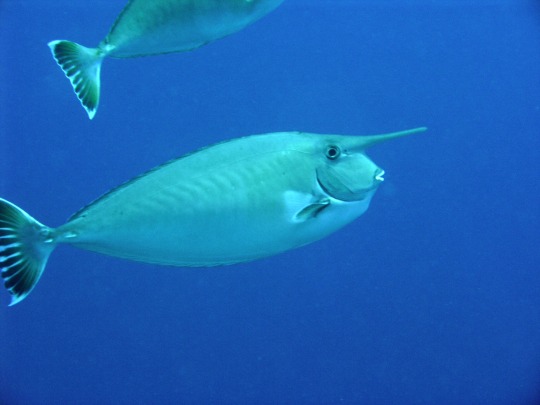
“Unicorn Fish” - Naso brevirostris

Tuna
In the shallows of the reefs, we found Nemo!! (Clown fish are the cutest), these crazy neon blue worms that hide when you splash water at them, and other smaller fish. Some of my other favorites below:
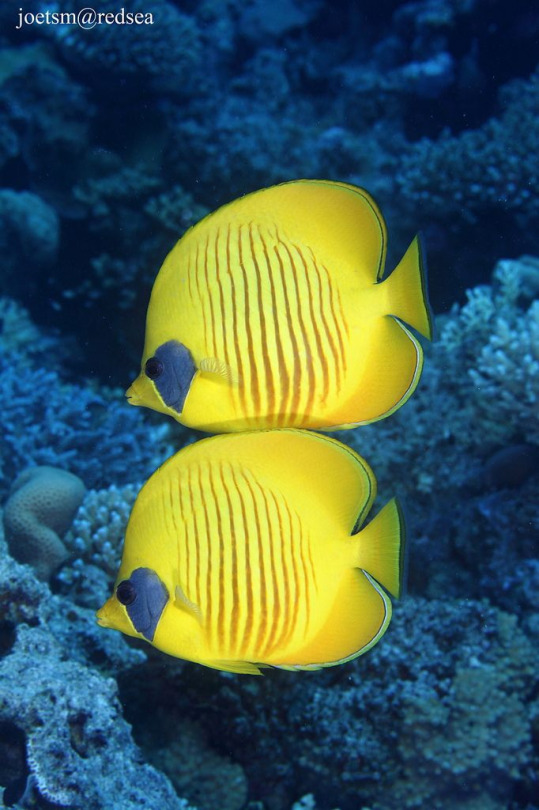
Butterfly fish. So cute, they were always swimming in pairs.

Five banded Damselfish. I could just swim right in the middle of a school of them.
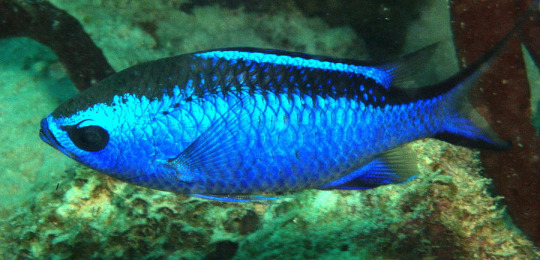
Blue Puller Damsel Fish
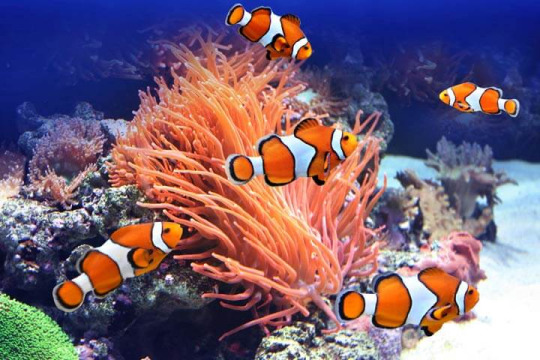
Bi-color Clown Fish Nemo!)
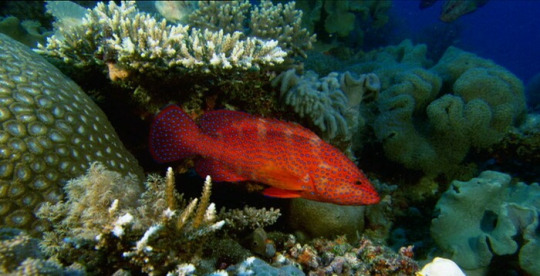
Coral Trout

Giant Clams
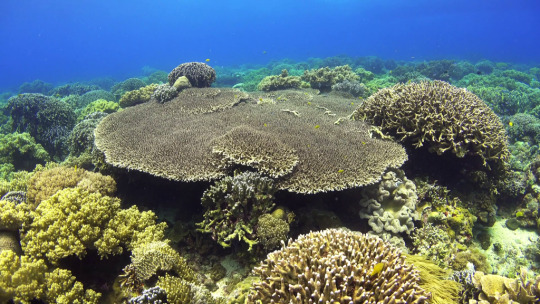
Table Coral
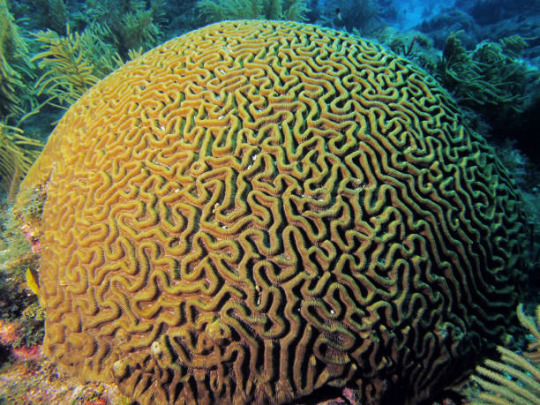
Brain Coral
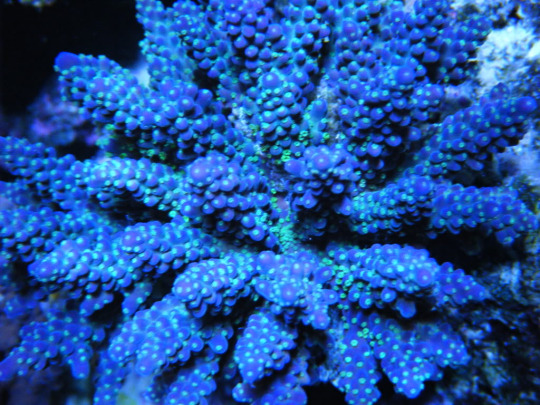
Blue Coral
Each dive was about an hour and I didn’t want to come back each time. It was beyond words...]


Pics from rear of the Rum Runner at dusk
The other thing that is amazing about being out on the reef is the sunset and at night there is almost no light and we were out on a clouody night. We had dinner and a beer and headed to bed in our tiny bunks. I don’t think I have ever been so tired. I’m pretty sure I was asleep by 8pm.

The next day we were up at 7am for our morning dive. The first of two for the final day. On each dive the reefs got progressively more amazing (maybe because I could finally fully relax and enjoy them) The abundance of fish chasing each other around the reef and hiding in little reef caves was phenomenal. On our final dive of the day, we swam out to a large, shallow thin reef, with deep crevasses running through the reef. I was swimming a little further away from my companions, near a crevasse, and all of a sudden a HUGE fish came out of the black of the crevasse and swam right past my face. It was what is known as a Humphead Wrasse. They are one of the largest fish in the reef. The one I saw was easily 4 feet long.
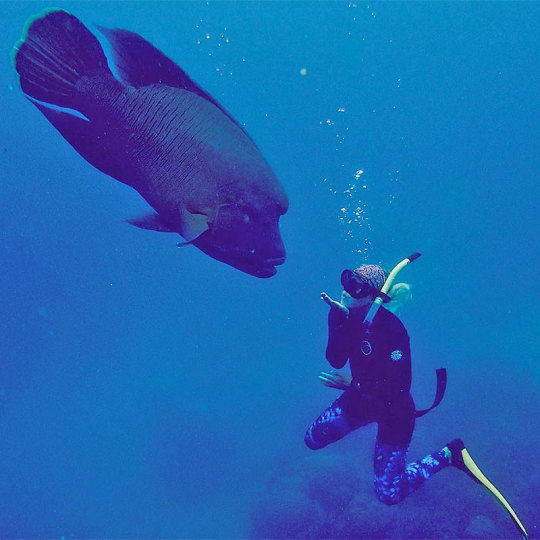
Humphead or Maori Wrasse (They can live up to 30 years, but are currently on the endangered species list)
Of course, I immediately thought it was something that was going to eat me. I panicked and swam down to avoid it, this led to me taking in a ton of water into my snorkel and completely forgetting how to blow it out again. I ended up swallowing a TON of salt water in my panic. I eventually pulled myself together and figured out the fish was completely harmless. I then took off in pursuit of it. After sprinting after it for several minutes I finally caught up to it and swam alongside of it for what felt like hours, probably a minute or so. Then, it hit me...I had just swallowed an inhumane amount of salt water and was completely wiped from chasing the fish. My bravado in being one of the non-pukers caught up to me. All of a sudden, I just lost my cookies and puked in the ocean. I had officially left my mark (and my breakfast) on the Great Barrier Reef. And that friends, was my final hurrah on the Reef. The Wrasse had disappeared back to the depths of the ocean and it was time for me to swim back to the boat. Epic, right?
Anyway, the conclusion of this story is that I continue to leave my breakfast in the GBR for the rest of the 3 hour trip back to Cairns. Seasickness is no joke, folks. Lesson learned, don’t eat a giant breakfast, swallow a ton of salt water and then ride on rough water for three hours. Was it worth it? YYYYYEEEESSSSSSS! In fact, I couldn’t ask for a more hilarious and epic final hours on the Reef. This will probably go down as one of the best experiences of my life. It was also one of the best moments ever to stand on solid ground, take a shower in my hostel, take some anti-nausea medicine and sleep!
3 notes
·
View notes
Link
#spotted unicornfish#Short-nosed Unicornfish#(Naso brevirostris#Naso brevirostris#pacific ocean#indian ocean#intotheblue.it#intotheblue#dive#snorkeling
0 notes
Photo

Colorful sea life from the Indian Ocean! From top to bottom: Sculptured Slipper Lobster (Parribacus antarcticus), Spotted Unicornfish (Naso brevirostris), Sharpnose Pufferfish (Genus Canthigaster), and Blue Swimming Crab (Portunus pelagicus). #SciArt by Louis Renard for his Poissons, Ecrevisses et Crabes (1754). Taxonomy tags come from Fishes, Crayfishes and Crabs: Louis Renard's Natural History of the Rarest Curiosities of the Seas of the Indies (1995) by Professor Theodore W. Pietsch. Contributed for digitization by Ernst Mayr Library, Museum of Comparative Zoology, Harvard University to #BiodiversityHeritageLibrary. http://www.biodiversitylibrary.org/page/50095173 ~~~~~~~~~~~~~~~~~~~~~~~~~~~~~~~~~~~~ #Lobster #Crab #Fish #Ichthyology #InvertebrateZoology #Invertebrates #Ocean #IndianOcean #Sea #BHLib #Biodiversity #NaturalHistory #Biology #ScientificIllustration #ScientificArt #OpenAccess #LibrariesofInstagram #Libraries #SciArtFix
#crab#fish#invertebrates#biodiversity#sciartfix#scientificart#librariesofinstagram#ocean#sciart#openaccess#invertebratezoology#libraries#bhlib#biology#ichthyology#indianocean#scientificillustration#naturalhistory#biodiversityheritagelibrary#lobster#sea
14 notes
·
View notes
Video
Einhorn-Hornbader - Naso brevirostris - Spotted Unicornfish by Stefan Köder Via Flickr
0 notes
Photo

I Pesci Chirurgo – The Surgeonfishes - For English version please click here I pesci chirurgo, in inglese surgeonfishes, abbracciano 3 sottofamiglie, 6 Generi e ben 72 specie. Fanno tutti parte dell’ordine Perciformes, sottordine Acanthuroidei e famiglia Acanthuridae. Distribuzione di acanturidi in natura, in alto nel blu si vedono Nasi brevirostris, in mezzo si vede un Acanthurus sohal ed in basso si #articoli, #fishes, #pesci, #techsection #acanthurus, #chirurghi, #fishes, #foto, #naso, #pesci, #photos, #pictures, #surgeonfishes, #zebrasoma #danireef #acquariomarino #acquario http://ift.tt/2qAGPyZ Follow us on DaniReef.com http://ift.tt/2rTygTM
0 notes
Text

#artists on tumblr#unicorn fish#Naso brevirostris#ichthyology#fishblr#scopophobia#surrealism#weirdcore#power lines
152 notes
·
View notes
Photo

Spotted unicornfish (Short-nosed unicornfish)
Yes, unicornfish exist! and there are about 20 species of them, belonging to the genus Naso, in the Acanthuridae Family.
This one, for example, is Naso brevirostris (Perciformes - Acanthuridae), distinctive by its long, broad-based tapering horn before eye (a bump on forehead of juveniles). This species is olive-brown to grey; has many small dark spots on the head and lower body, and many thin dark bars on the upper body; the tail is whitish with dark blotch at base.
Naso brevirostris is widespread and cosmopolitan, occupying a wide range of habitats. It is found in the Pacific and Indian oceans.
Other common names: Palefin Unicornfish, Shortsnout Unicornfish, Brown Unicornfish, Shortnosed Kala, Shortnose Unicornfish, Longnose Unicornfish, Corne, Nasique, Nason à Rostre Court, Nason Pointillé.
References: [1] - [2] - [3]
Photo credit: ©Sue Merrifield
Locality: Maldives
#nature#animals#spotted unicornfish#naso brevirostris#naso#maldives#fauna#underwater#sea life#fish#fishes#unicornfish#perciformes#acanthuridae#zoology#ichthyology#original
377 notes
·
View notes
Text
Naso brevirostris / ツマリテングハギ

Naso brevirostris
Naso brevirostris (Spotted unicornfish) is a type of unicornfish found in Pacific Ocean, Indian Ocean, and Red Sea. They have spines on the base of the tail fin.
ツマリテングハギ。太平洋、インド洋、紅海などで見られる。 尾びれの付け根にトゲあり。
Classification Animalia Chordata Actinopterygii Perciformes Acanthuridae 動物界 脊索動物門 条鰭綱 スズキ目 ニザダイ科 Photo taken at Tokai University Marine Science Museum
#Spotted unicornfish#Naso brevirostris#Acanthuridae#Perciformes#Fish#Tokai University Marine Science Museum#ツマリテング��ギ#ニザダイ科#スズキ目#魚類#東海大学海洋科学博物館
0 notes
Photo

101 notes
·
View notes
Photo

This is Naso brevirostris, known as the spotted unicorn fish
4 notes
·
View notes
